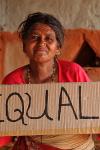Gender issues in surveys

In 2006, the Inter-agency and Expert Group on Gender Statistics (IAEG-GS) was formed to foster collaboration and cooperation for the development of gender-relevant and sex-disaggregated statistics. The IAEG-GS selected a set of gender indicators that built on the Beijing Platform for Action and the Millennium Development Goals (MDGs).
Since then, other work and initiatives have been launched to improve gender statistics. These include the production of guidelines and manuals such as Statistics Sweden’s Engendering Statistics, United Nations Economic Commission for Europe (UNECE) and World Bank’s Developing Gender Statistics, United Nations Statistics Division’s (UNSD) Gender Statistics Manual (forthcoming), and UNSD’s Guidelines for Producing Statistics on Violence against Women (forthcoming). Further, the recently launched Evidence and Data for Gender Equality (EDGE) initiative is developing methodologies and guidelines for entrepreneurship and asset data.
To complement these initiatives, the IHSN initiated a project to assess if and how (well) survey programs in developing countries provide the necessary information to produce gender indicators and conduct analysis on gender issues. The objective of the project is twofold: To provide a detailed inventory of available information, identify data gaps, and inform users about available data; and to identify areas where improvement of survey methods is most needed.
| Project status: | Open |
| Sponsor(s): | UK Department for International Development - DFID (Trust Fund TF011722 administered by the World Bank) |
| Implemented by: | The project is implemented by the World Bank Development Data Group, in collaboration with counterparts from multiple partner organizations (i.e., FAO, ILO, UIS, UNSD, UN Women, WHO, World Bank). |
Approach:
Assessing how (well) gender issues are addressed in surveys involves the following five activities:
1. Identification of key gender issues potentially covered by household surveys. Gender is a cross-cutting issue, so it is important to define the scope of the assessment. We used the list of indicators recommended by the EDGE program, gender issues described in key documents, and consultation with gender specialists in several agencies to define the scope of our assessment. The list of indicators and key documents are provided in the "Related resources" section.
United Nations Statistics Division - May 2013DownloadThe gender statistics manual published by the United Nations Statistics Division provided a framework for our assessment. The manual covers four topics: 1) Users, uses and production of gender statistics; 2) Bringing gender issues into statistics; 3) Integrating a gender perspective into data collection; 4) Analysis and presentation of gender statistics.2. Translation of these data needs into a list of variables and development of an assessment form. To assess the relevance and reliability of survey questionnaires, we need to identify the questions and variables obtained by implementing the survey. This phase produces an assessment form, consisting of a "questionnaire on survey questionnaires." The assessment form is a critical component of the project, and much attention is devoted to its review and testing by multiple experts and agencies. Instructions on completing the form are also produced at this stage. A draft version of the form is being developed as a PDF form (provided below). The final version will consist of a web-based form, which will also be made available to other teams/agencies interested in conducting similar projects, which will allow us to expand the scope and coverage of the project
IHSN and World Bank - January 2013DownloadThis document provides a PDF version of the form used to conduct an inventory of variables related to gender issues in household surveys, with a short instruction manual. A web-based version of this form is being used by the IHSN to conduct the assessment. The form is provided for information. The development of this form has benefited from input from many agencies and experts.3. Evaluation of a large collection of household surveys and censuses. The geographic coverage of this exercise consists of all low- and middle-income countries (based on the World Bank classification of countries). When and where available, the project will assess the following operations in these countries:
- Population and housing censuses
- Household income and expenditure surveys or equivalent
- Living Standards Measurement Study (LSMS)
- Core Welfare Indicators Questionnaire (CWIQ) surveys
- Other country-specific socioeconomic monitoring surveys
- Demographic and Health Surveys (DHS)
- Multiple Indicator Cluster Surveys (MICS)
- Agricultural censuses or surveys
- Labor force surveys
- Financial inclusion surveys (FINDEX)
- Other surveys (those with nationwide coverage and gender-specific surveys are given priority)
The project prioritizes the most recent surveys for assessment, but will eventually cover as many data collection activities as possible from the year 2000 to the present. A list of surveys identified for the assessment is provided below. This list will be regularly updated to add surveys and other information.
IHSN / World Bank - 24 February 2014DownloadThis MS-Excel file provides the list of surveys and censuses that the IHSN has assessed from a gender perspective.4. Production of a meta database. All information collected using the assessment form will be stored in a database format and also made available in MS-Excel, Stata, and SPSS formats for easy analysis. A web-based user interface will be developed to allow public access to this "data discovery" tool. The database in other formats will also be made publicly available.
5. Production of a report or working paper on "How (well) are gender issues covered in surveys and censuses?". Production of the report will be coordinated by the IHSN and World Bank, but other interested agencies will be invited to collaborate as co-authors or reviewers.

